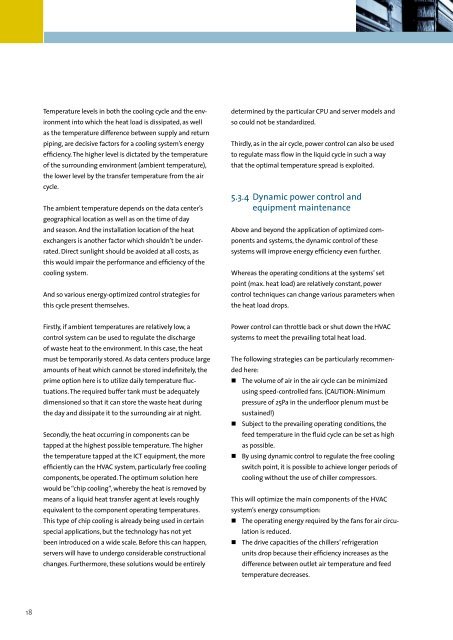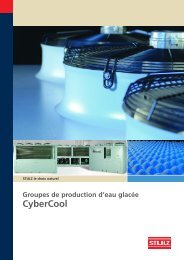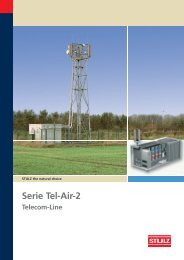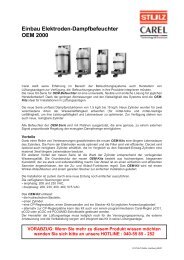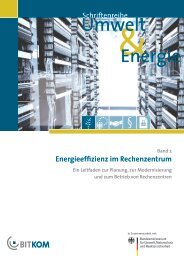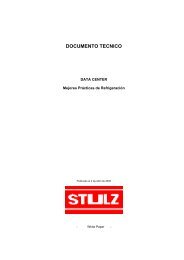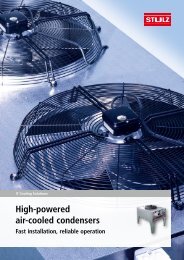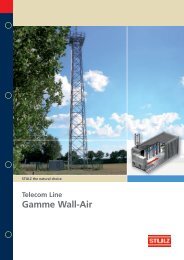Climate protection needs energy efficient data centers - Stulz GmbH
Climate protection needs energy efficient data centers - Stulz GmbH
Climate protection needs energy efficient data centers - Stulz GmbH
You also want an ePaper? Increase the reach of your titles
YUMPU automatically turns print PDFs into web optimized ePapers that Google loves.
Temperature levels in both the cooling cycle and the environmentinto which the heat load is dissipated, as wellas the temperature difference between supply and returnpiping, are decisive factors for a cooling system’s <strong>energy</strong>efficiency. The higher level is dictated by the temperatureof the surrounding environment (ambient temperature),the lower level by the transfer temperature from the aircycle.The ambient temperature depends on the <strong>data</strong> center’sgeographical location as well as on the time of dayand season. And the installation location of the heatexchangers is another factor which shouldn’t be underrated.Direct sunlight should be avoided at all costs, asthis would impair the performance and efficiency of thecooling system.And so various <strong>energy</strong>-optimized control strategies forthis cycle present themselves.determined by the particular CPU and server models andso could not be standardized.Thirdly, as in the air cycle, power control can also be usedto regulate mass flow in the liquid cycle in such a waythat the optimal temperature spread is exploited.5.3.4 Dynamic power control andequipment maintenanceAbove and beyond the application of optimized componentsand systems, the dynamic control of thesesystems will improve <strong>energy</strong> efficiency even further.Whereas the operating conditions at the systems’ setpoint (max. heat load) are relatively constant, powercontrol techniques can change various parameters whenthe heat load drops.Firstly, if ambient temperatures are relatively low, acontrol system can be used to regulate the dischargeof waste heat to the environment. In this case, the heatmust be temporarily stored. As <strong>data</strong> <strong>centers</strong> produce largeamounts of heat which cannot be stored indefinitely, theprime option here is to utilize daily temperature fluctuations.The required buffer tank must be adequatelydimensioned so that it can store the waste heat duringthe day and dissipate it to the surrounding air at night.Secondly, the heat occurring in components can betapped at the highest possible temperature. The higherthe temperature tapped at the ICT equipment, the more<strong>efficient</strong>ly can the HVAC system, particularly free coolingcomponents, be operated. The optimum solution herewould be “chip cooling”, whereby the heat is removed bymeans of a liquid heat transfer agent at levels roughlyequivalent to the component operating temperatures.This type of chip cooling is already being used in certainspecial applications, but the technology has not yetbeen introduced on a wide scale. Before this can happen,servers will have to undergo considerable constructionalchanges. Furthermore, these solutions would be entirelyPower control can throttle back or shut down the HVACsystems to meet the prevailing total heat load.The following strategies can be particularly recommendedhere:• The volume of air in the air cycle can be minimizedusing speed-controlled fans. (CAUTION: Minimumpressure of 25Pa in the underfloor plenum must besustained!)• Subject to the prevailing operating conditions, thefeed temperature in the fluid cycle can be set as highas possible.• By using dynamic control to regulate the free coolingswitch point, it is possible to achieve longer periods ofcooling without the use of chiller compressors.This will optimize the main components of the HVACsystem’s <strong>energy</strong> consumption:• The operating <strong>energy</strong> required by the fans for air circulationis reduced.• The drive capacities of the chillers’ refrigerationunits drop because their efficiency increases as thedifference between outlet air temperature and feedtemperature decreases.18


